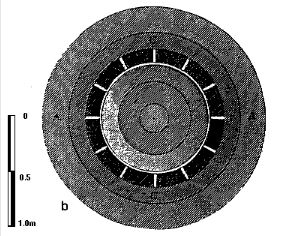

- Pipes. (Tobacco),
- ... The clay of which tobacco pipes are made is perfectly white, and is distinguished from other types of clay by its great adhesion to the tongue, which is well known to be very considerable when baked, in consequence to its affinity to water; in the raw state this property is perceptible in a slight degree. The pipe clay is found at Maidenhead in Kent, in large lumps, which are purified by dissolving them in water in large pits; this solution being well stirred up, is poured off into another, where it subsides and deposits the clay; the water becoming clear is run off, and the clay at the bottom is left till sufficiently dry for use; by this means the smallest stones or particles of foreign matter are left at the bottom of the first pit; the clay thus prepared, is spread on a board and beaten with an iron bar to temper and mix it; then it is divided into pieces each of which will be the proper size to form a tobacco pipe; each of these pieces is rolled under the hand into a long roll with a bulb at one end to form the bowl, and in this state they are laid up in parcels for a day or two, until they become sufficiently dry for pressing, which is the next process, and is conducted in the following manner. The roll of clay has a small wire, (Fig. 5. Pl. 138.) thrust nearly through its whole length to form the tube, and is put in between two iron moulds, one of which is shown in Fig. 6, of the same plate, 138, each has imprinted in it the figure of one half of a pipe, and therefore when put together, the cavity between them is the figure of a whole pipe. They are put together by three pins at a, b, c, which enter holes in the opposite half. The moulds, with the clay in them, are now put into the press, Fig. 1 and 2. It consists of an iron frame formed of two plates like dd, one of which is fixed down to the bench aa, and the other is pressed towards it by a screw turned round by the handle c. The moulds are put in between the two plates, and the screw being turned round presses them together, imprinting the figure of a pipe on the clay included between them. The lever k, is next depressed, and the stopper i, (Shown enlarged in Fig. 3.) entering the mould, forms the bowl of the pipe, and the wire, Fig. 5, which is all the while in the pipe, is thrust backwards and forwards to prick the tube completely into the bowl. The press is now opened by turning back the screw e, and the moulds taken out. The knife, Fig. 4, is thrust into the cleft d, Fig. 6, of the mould to cut the end of the bowl flat, the wire is carefully withdrawn, and the pipe taken out of the mould. These pipes are laid up two or three days, till they become stiff, when they are dressed with curved scrapers to take off the impressions of the joints of the moulds, and they are polished and smoothed by rubbing them with a piece of hard wood cut with a semicircular cleft. They are then baked in the furnace, Figs. 7 and 8.
- They (the pipes) are then baked in a furnace. It is built within a cylinder of brickwork AA, having a dome at top, and a chimney B, arising from it to a great height, to cause a sufficient draught. Within this is a lining of fire brick marked CC, having the fire place D, at the bottom of it. The pot or crucible EE, which contains the pipes, if formed of broken pieces of pipes, and cemented together by fresh clay and hardened by burning. This crucible has a number of vertical flues surrounding it, shown in the plan Fig. 7, and conducting the flame from the fire grate up to the dome of the fire brick lining CC, and through a hole in its dome into the chimney. Within the crucible several projecting rings are made, and upon these the bowls of the pipes are supported as in the figure at aa; the ends resting upon circular pieces of pottery which stand on small loose pillars dd, set up for the purpose in the centre. By this arrangement a small crucible can be made to contain 50 gross of pipes, and without loading one upon the other so as to endanger the crushing or deforming any by the weight of the others. The pipes are put into the pot at one side when the crucible is open, but when filled, this orifice is made up with broken pipes and fresh clay. The fire brick lining CC, is also made good on that side, and the furnace is lighted. At first the heat is gentle, but is increased by degrees to the proper temperature, and continued for seven to eight hours; when it is damped by stopping the hole in the crown of the lining CC, with a flat plate of fire clay.
When the furnace is cold the pipes thus baked are ready for sale. (From Good's Pantologia.)